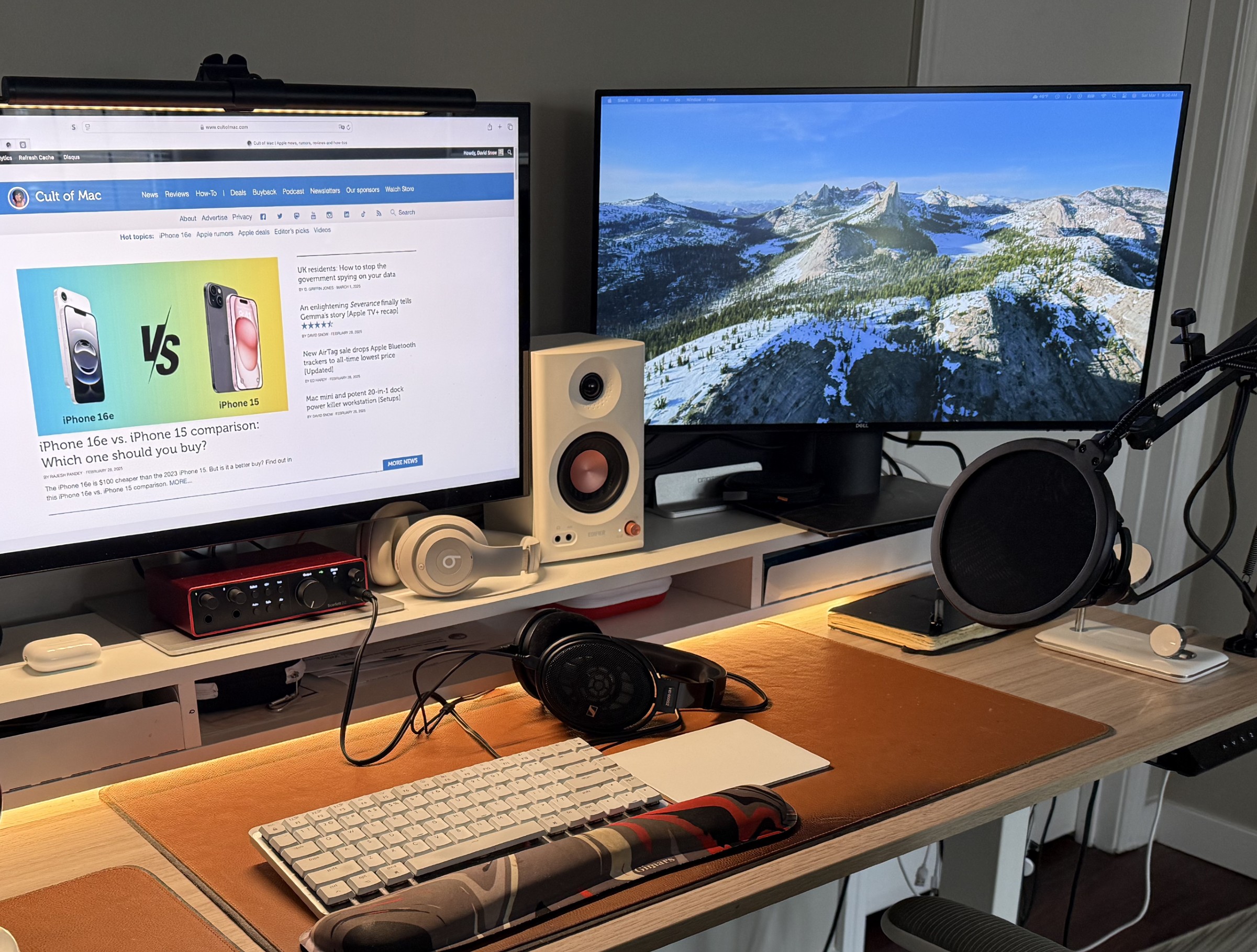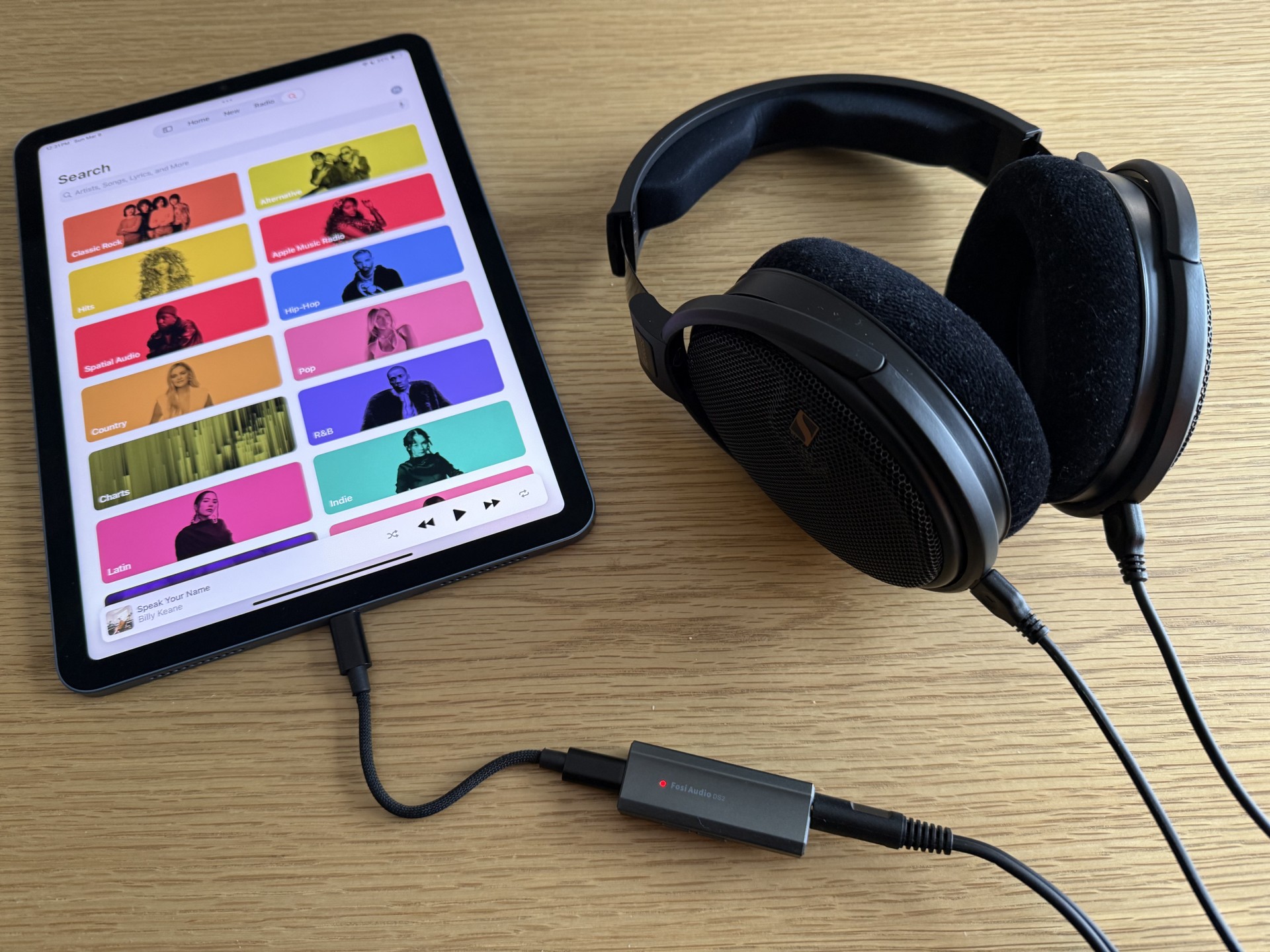Ever wondered how closed-back and open-back headphones differ? Is one or the other better for your uses in your computer setup and elsewhere? What the heck is “impedance?” I recently experimented with both open- and closed-back cans in my evolving setup. I’ve laid out all the considerations and key differences for you below. And you can find my gear in the links list at the bottom of this article.
This post contains affiliate links. Cult of Mac may earn a commission when you use our links to buy items.
Should you use closed-back or open-back headphones?
Beats' flagship over-ear headphones feature personalized Spatial Audio, USB-C lossless audio and up to 40 hours of battery life.
- Lossless wired audio capability
- Apple and Android compatibility
- Available in multiple colors
- Lacks ear-detection sensors
- No Apple H1 or H2 chip
My M4 Pro MacBook setup has seen many changes over the past few years. That includes the recent addition of an audio interface and condenser microphone, on top of the previously added Edifier studio-monitor speakers. I also found a good deal on a lightly used pair of open-back headphones I wanted to try, Sennheiser HD660S2. So I added them to my headphones stable, which also includes Beats Studio Pro (closed back).
I’d dragged my feet on setting up the audio interface and mic. But I really wanted to see if the audio interface would function well as a headphone amp. You only really need one for high-impedance headphones, because most small devices don’t bring enough voltage to headphone jacks to make them sound their best. My new-to-me Sennies rate at 300 Ohms (Ω) impedance, whereas my Beats Studio Pro cans go with just 38Ω. So I got myself an affordable Fosi Audio DS2 headphone amp dongle to run between the Sennheisers and my iPhone and iPad Air, which worked great. More on impedance below.
Fundamentals: Closed-back vs open-back headphones

Photo: David Snow/Cult of Mac
At the core of headphone design lies the distinction between closed back and open back models. The fundamental difference affects not only the sound quality but also how you’ll use your headphones in various environments.
Choosing between closed back vs open back headphones ultimately comes down to your listening preferences, environment and intended use. Consider factors like sound-isolation needs, desired soundstage and whether you’ll be using them in public or private settings. Don’t forget to factor in impedance and potential amplification needs, especially if you’re looking at high-end or professional-grade headphones. For many people, funds-allowing, owning at least one of each is the best course. But for most people, a solid closed-back choice is just fine.
Closed-back headphones: Isolation and immersion
Closed-back headphones feature sealed ear cups that enclose your ears completely. This design offers several advantages:
- Isolation from external noise / passive noise cancellation. The sealed design blocks out ambient sounds, making these headphones ideal for noisy environments or when you don’t want to disturb others.
- Enhanced bass response. The closed chamber creates a more pronounced bass effect, which many listeners find enjoyable for certain music genres.
- Minimal sound leakage. Your audio remains private, making these headphones suitable for use in public spaces or shared offices.
- Immersive listening experience. The isolation can create a more focused and immersive soundstage, particularly for genres that benefit from a “in-your-head” sound.
However, closed back designs also have some drawbacks:
- Potential for ear fatigue. The sealed environment can lead to heat build-up and pressure, which may cause discomfort during extended listening sessions.
- Less natural soundstage. The closed design can make the audio feel more confined, which some audiophiles find less appealing for certain types of music.
Open-back headphones: Natural sound and comfort
Open-back headphones, as the name suggests, have perforated ear cups that allow air and sound to flow through. This design philosophy leads to several cool characteristics:
- Natural and spacious sound. The open design creates a wider, more natural soundstage that many listeners describe as “airy” or “room-like.” Imaging, or the ability to place instruments in the stereo field you’re hearing, is often better with open-back designs. That can enhance the listening experience for complex musical arrangements.
- Reduced ear fatigue. The airflow helps prevent heat build-up, making these headphones more comfortable for long listening sessions.
- Lighter weight. Open-back designs often use less material, resulting in a lighter overall headphone.
- Enhanced awareness of surroundings. You can still hear ambient sounds, which can be a safety feature in some situations.
Open back headphones trade-offs include:
- Sound leakage. Others around you can hear what you’re listening to, making these less suitable for public use or shared spaces.
- Less isolation from external noise. Ambient sounds can interfere with your listening experience in noisy environments.
- Potentially weaker bass response. The open design may result in less impactful bass compared to closed-back models.
Decoding headphone impedance: Low vs. high
This portable USB-C to AUX headphone amp and DAC dongle comes with a 3.5mm and 4.4 balanced hi-res dual outputs.
- Compact and portable
- Hi-res audio-capable
- Great for boosting high-impedance headphones
- Affordable
- Your mileage may vary depending on your headphones and music devices
Understanding headphone impedance is crucial for selecting the right audio setup for your needs. Impedance — again, measured in Ohms (Ω), named after a German physicist — represents the headphones’ resistance to electrical current.
Low-impedance headphones (under 100Ω)
Low impedance headphones are designed for use with portable devices and consumer electronics. They offer several benefits. They’re easy to drive with minimal power, which makes them ideal for use with laptops, tablets and smartphones. Their high sensitivity work well at lower voltage, like with battery-powered devices. So such headphones work across a wide range of consumer devices. Popular low impedance headphones include many consumer-grade models from brands like Sony, Bose and Beats, like my Beats Studio Pro or the Scarlett SH450 pair that came with my audio interface bundle (32Ω) .
High-impedance headphones (over 100Ω)
High impedance headphones are typically designed for professional use or audiophile listening. They have distinct characteristics, like more detail in the sound and good compatibility with professional equipment. But to reach their full potential, these headphones often need a separate headphone amplifier. Examples of high impedance headphones include Beyerdynamic DT 990 Pro (250Ω) and my Sennheiser HD660S2 (300Ω).
Role of headphone amplifiers

Photo: David Snow/Cult of Mac
A quality headphone amplifier can significantly enhance the audio performance of your headphones, especially for high-impedance models. Here’s why amplifiers matter:
- Power delivery. Amplifiers provide the necessary power to drive high impedance headphones to their full potential, ensuring optimal volume and sound quality.
- Improved dynamic range. A good amplifier can help reproduce subtle details in music that might be lost when using underpowered sources.
- Better control. Amplifiers offer more precise volume control and can help reduce distortion at higher listening levels.
- Impedance matching. Proper amplification ensures the right amount of power is delivered to your headphones, optimizing their performance.
When choosing an amplifier, consider factors like:
- Output power: Ensure it can provide enough power for your headphones’ impedance.
- Input/output options: Look for compatibility with your audio sources and headphones.
- Sound signature: Some amplifiers color the sound, while others aim for neutrality. Choose based on your preference.
Typical headphone impedance ranges
Typical headphone impedance ranges from 16Ω for consumer models to 600 – 1000Ω for professional studio headphones. Here’s a general breakdown:
- 16-32Ω: Most consumer headphones, earbuds and gaming headsets
- 32-100Ω: Many mid-range and some high-end consumer headphones
- 100-300Ω: Professional studio headphones and some high-end consumer models
- 300-600Ω and up: Specialized high-end headphones for audiophiles and professional use
Remember, higher impedance doesn’t always mean better sound quality. It’s about matching the headphones to the right audio source and amplification.
Matching headphone impedance to headphone amplifiers
Matching your headphone amplifier impedance to your headphones ensures optimal power transfer and sound quality. Here are some guidelines:
- Output impedance. An amplifier’s output impedance should generally be 1/8th or less of the headphone’s impedance for optimal damping factor. That’s right: Don’t match amplifier and headphones impedance. The amp can be a lot lower.
- Power output. Ensure the amplifier can provide enough power for your headphones. High impedance headphones typically require more voltage, while low impedance ones need more current. Some devices make up the difference themselves, like the headphone jack of recent MacBook Pro models like my M4 Pro. They sense headphone impedance and adjust voltage to the headphone jack.
- Impedance range. Look for amplifiers that specify a wide impedance range to accommodate various headphones you might use.
- Gain settings. Some amplifiers offer adjustable gain, which can be useful for matching with different headphone sensitivities and impedances.
By considering these factors, you can create an audio setup that brings out the best in your headphones, whether they’re open back or closed back, low impedance or high.
Buy the gear discussed in this guide on Amazon:
These wired audiophile stereo headphones offer deep sub bass, optimized surround sound, transducer airflow, vented magnet system and voice coil.
- Great sound
- Wide sound stage
- Comfortable fit
- Somewhat expensive
- Proprietary Sennheiser connectors (other cables won't work)
![Closed-back vs. open-back headphones: How to choose [Buying guide] closed back vs open back headphones](https://www.cultofmac.com/wp-content/uploads/2025/03/closed-back-vs-open-back-headphones-1020x765.jpg)




